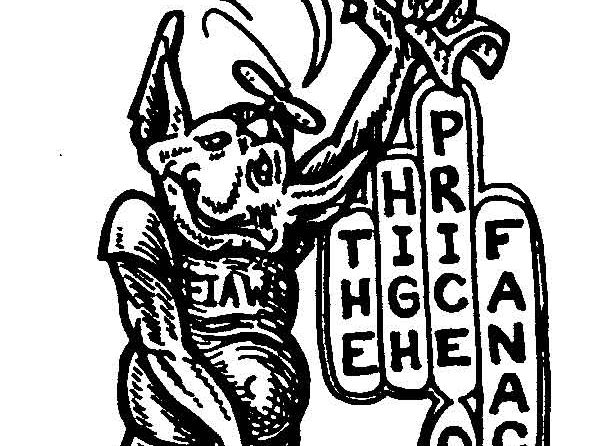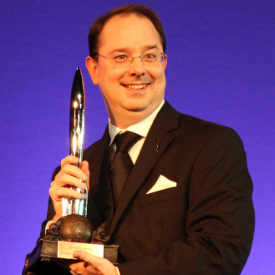
Science fiction fandom or SF fandom is a community or fandom of people actively interested in science fiction and fantasy and in contact with one another based upon that interest. SF fandom has a life of its own, but not much in the way of formal organization (although clubs such as the Futurians [1937–1945], the Los Angeles Science Fantasy Society [1934–present], and the National Fantasy Fan Federation [1941–present] are recognized features of fandom).
Most often called simply “fandom” within the community, it can be viewed as a distinct subculture, with its own rituals and jargon; marriages and other relationships among fans are common, as are multi-generation fannish families.
Science fiction fandom started through the letter column of Hugo Gernsback’s fiction magazines. (Amazing Stories foremost among them!) Not only did fans write comments about the stories — they sent their addresses, and Gernsback published them. Soon, fans were writing letters directly to each other, and meeting in person when they lived close together, or when one of them could manage a trip. In New York City, David Lasser, Gernsback’s managing editor, nurtured the birth of a small local club called the Scienceers, which held its first meeting in a Harlem apartment on December 11, 1929. Almost all the members were adolescent boys. Around this time a few other small local groups began to spring up in metropolitan areas around the United States, many of them connecting with fellow enthusiasts via the Science Correspondence Club. In May 1930 the first science fiction fan magazine, The Comet, was produced by the Chicago branch of the Science Correspondence Club under the editorship of Raymond A. Palmer (later a noted editor of Amazing Stories) and Walter Dennis. In January 1932, the New York City circle, which by then included future comic book editors Julius Schwartz and Mort Weisinger, brought out the first issue of their own publication, The Time Traveller, with Forrest J Ackerman of the embryonic Los Angeles group as a contributing editor.
In 1934, Gernsback established a correspondence club for fans called the Science Fiction League, the first fannish organization. Local groups across the nation could join by filling out an application. A number of clubs came into being around this time. LASFS (the Los Angeles Science Fantasy Society) was founded at this time as a local branch of the SFL, while several competing local branches sprang up in New York City and immediately began feuding among themselves.
The Los Angeles Science Fantasy Society, Inc., or LASFS is a science fiction society with its headquarters in Van Nuys, a neighborhood in Los Angeles, California, in the San Fernando Valley, north of L.A. city. LASFS HQ is located at the corner of Tyrone & Aetna streets, near the Van Nuys Orange Line station. LASFS is the oldest continuously operating science fiction club in the world, helped considerably in that record by being one of the few to own a clubhouse. The organization continues to hold regular weekly meetings on Thursdays. The club maintains a private lending library of books, videos, and other genre-related materials, for use by members.
The club has hosted the World Science Fiction Convention several times, initiated the regional science-fiction convention Westercon, and hosts a yearly science fiction convention called Loscon. It maintains a web site and discussion forum, publishes (at irregular intervals) an amateur magazine called Shangri L’Affaires, and hosts the collations of a weekly amateur press association, APA-L. The LASFS monthly newsletter, De Profundis, is named for the club motto, De Profundis ad Astra (“From the Depths to the Stars”). DeProf is available (in PDF format) for reading at the LASFS web site, and can be obtained by writing its editor/publisher, Marty Cantor, or at the official LASFS site: LASFS
In 1935, PSFS (the Philadelphia Science Fiction Society, 1935 – present) was formed. The next year, half a dozen fans from NYC came to Philadelphia to meet with the PSFS members, as the first Philadelphia Science Fiction Conference, which some claim as the world’s first science fiction convention.
The Philadelphia Science Fiction Society (PSFS) is a science fiction club in Philadelphia, Pennsylvania. PSFS is the second oldest group in science fiction fandom and hosted what is considered by some to be the first science fiction convention. Anyone living in the greater Philadelphia area and interested in science fiction, fantasy, horror, whether written or on TV or in the movies; SF, fantasy, and horror art; gaming, board games or video games; comic books/graphic novels; and related arts is welcome. Contact info: PSFS
Soon after the fans started to communicate directly with each other came the creation of science fiction fanzines. These amateur publications might or might not discuss science fiction and were generally traded rather than sold. They ranged from the utilitarian or inept to professional-quality printing and editing. In recent years, Usenet newsgroups such as rec.arts.sf.fandom, websites and blogs have somewhat supplanted printed fanzines as an outlet for expression in fandom, though many popular fanzines continue to be published. Science-fiction fans have been among the first users of computers, email, personal computers and the Internet.
Many professional science fiction authors, such as Robert Silverberg and Gregory Benford to name two, started their interest in science fiction as fans, and some still publish their own fanzines or contribute to those published by others.

A widely regarded (though by no means error-free) history of fandom in the 1930s can be found in Sam Moskowitz’s The Immortal Storm: A History of Science Fiction Fandom Hyperion Press 1988 ISBN 0-88355-131-4 (original edition The Atlanta Science Fiction Organization Press, Atlanta, Georgia 1954). Moskowitz was himself involved in some of the incidents chronicled and has his own point of view, which has often been criticized.
SF writer Cory Doctorow calls science fiction “perhaps the most social of all literary genres”, and states, “Science fiction is driven by organized fandom, volunteers who put on hundreds of literary conventions in every corner of the globe, every weekend of the year.”
Wherever you live, there’s most likely a science fiction and fantasy club already operating in your area. Just take a look on the Internet. Some clubs, like NESFA (the New England Science Fiction Association) even list other clubs in their area: see NESFA
These clubs are international in scale and scope. Even London has one, The Science Fiction Book Club, which meets on the 2nd and 4th Mondays of the month. So does Rhode Island home to Weird Tales writer H.P. Lovecraft, The Rhode Island Science Fiction Club.
So, there you have it, there are science fiction clubs everywhere, and have been for over eighty years. If you’ve been interested in getting into fandom, contact one in your area and join. It’s a great way to meet new friends. It’s also a lot of great fun. You might even get the bug and start your very own fanzine, and have it reviewed in The Club House….
***
Well, this has been a very slow week for fanzines. It’s clear we need more new club members publishing their own zines, and soon.

Drink Tank #361: November 2013. Weekly (usually). 16-pages. Edited by Chris Garcia. Great cover of an unidentified fan having fun at an unknown convention. Chris begins with his usual editorial, this time it’s “On JFK—Fifty Years and a Lifetime Later,” wherein Chris recaps the known facts from the viewpoint of his generation. He still tap dances on the Oswald conspiracy theory while tying his thread to the other various Strange Killers of All Time, like Jack the Ripper. He ends pretty much on the cliché that the more things change the more they stay the same as he awaits the coming anniversary of the Watergate news coverage. Next we have “Loscon 40’s S-F Classic,” by John Hertz. The Loscon 40 annual s-f convention is this upcoming weekend (Nov. 29-Dec 1) at the L.A. Int’l Airport Marriott Hotel. If you’re in the area, and have some free time, you might want to check it out. Hertz is a guest-speaker at the event and his panel will be discussing Zenna Henderson’s “Deluge” (1963), a story of the People. In his brief article John covers the highlights, enough so to create interest, and well, go see his panel for the rest. Alexander Case follows with his “Anime 102” an update type article for those mainstream fans who haven’t kept up with anime as it has developed since the 1990s. In his article Case gives with several brief reviews of various anime television series. He makes his case with his deft treatment of his favored genre. Legendary Canadian BNF Murray Moore kicks off the letters of comments with a typical gem. Lloyd Penney follows with a very detailed and discursive letter covering an incredible amount of fannish ground. After the letters Yvette Keller reviews The Scroll of Years, by Chris Willrich. While Yvette doesn’t compare the book to Tristam Shandy, it does appear to be a rambling novel, covering a world of adventure and experience. This review is followed by an interview of Willrich as done by Keller. The interview is recommended reading.
***

Counter Clock #16: November 2013. Bimonthly. 24-pages. Edited by Wolf von Witting. Cover art by Wolf “Monica Marin (Crematorium Bucharest). CounterClock is mostly about European science fiction-fandom, its history and future, sf-conventions, the art of writing and fantastic film. It wasn’t Philip K Dick’s novel which inspired to the name of this fanzine, but rather the potential usefulness of certain wingdings. But it might as well have been P.K. Dick.
The ambition for this zine is to be regular quarterly. It contains reports from conventions all over Europe, historical accounts and letters of comment are more than welcome.
Wolf begins with an editorial/article on “The Process of Writing,” wherein he segues into the roots of his fannish beginnings at a 1984 Stockholm convention, NASACON V. A native of Helsinki, Wolf continues his thread about roots with a brief genealogical account. Did I forget to mention, his article is nicely peppered with very colorful photos, such as of the Recklinghausen majorette strikingly above the crowd. Wolf weaves his thread of family tragedy back to his starting point, 1984, and gives with several observations about the extremes with which Big Brother has infiltrated the European community. After his autobiographical perspective, Wolf gives us some short, brief items of universal interest ranging from exoplanets to statistics on English proficiency in Europe. One such snippet is the publication schedule for the next issue…January 2014. And his thoughts on producing a companion zine containing his ”boring poetry and lyrics.” After this interlude, Wolf continues with his autobiography in “Wooff, the Waffle—A Faneds Tale,” wherein he first and foremost demonstrates an incredible command of the English language. We find that Wolf pubbed his first fanzine in 1978, that he was better known as an illustrator during the 1980s than as a fan writer. In 1990 he gafiated, but by the end of that decade found his way back to fandom. Next Wolf concludes his WETZLAR 1956 Convention trilogy with a reprint of an article written by Gregory Benford and supplied by his twin, Jim. This is a very nicely written con report by a then 15-year-old Benford who successfully demonstrated that he could write. This long reprinted article is followed by another interlude of interesting, but random, snippets all somehow related to science fiction and fandom. This is followed by “LOC Around the Clock,” you guessed it, the letter column. Coincidentally featuring one written by John Hertz (see above review). Then there is the ubiquitous Lloyd Penney, not to mention several letters from the European contingent. Finally there is a long calendar listing of upcoming European events and conventions. This is truly an amazing zine. First because it is so readable and entertaining, second because it exceeds any expectations. It borders on the brilliant while giving insight into European fandom, its history, roots, and present direction. This zine is highly recommended reading.
***
Now for a facile segue from the European roots of fandom to all things Shaver, who had his roots in Amazing Stories…
Details are available at: Shavertron

Shavertron #2: Winter 1979. Quarterly. 6-pages. Edited by Richard Toronto. Once again we visit the mysterious world of Richard Shaver, and to some degree that of Charles Fort. Those two visionaries saw the world in the light of strange events controlled by unseen outside beings. They thought that all such bizarre happenings could be understood through this lens. They have managed to hook several generations on their beliefs, whether they are true, they make for some cogent reading. Richard Toronto began a lifelong interest in these things in the mid-1970s. He pursued his passion with an unusual vigor, getting in touch with all the key players, or their surviving kin, and finally when he thought he understood the whole, he began pubbing his own fanzine, Shavertron.
Shavertron, the fanzine, looks like it first appeared as a series of articles inside the pages of Ray Palmer’s Other Worlds. It has the personal touch of a scrapbook, with clipped newspaper articles which highlight the conspiracy theory or underscore the secret masters in control of weird events. It is by far the most unusual zine ever printed, and we are lucky that editor Toronto has decided to offer them all together once again. He doesn’t disappoint.
How can the reader go wrong with such articles as “Mystery Voice in Ship Crash,” “Pilot Goes Berserk,” and “Similar Suicides.” All these are news clippings of the strange events that regularly go unnoticed around the world. Peppered among them is a letter from Richard Shaver, the first true believer. In his editorial, Richard Toronto tells us that Shaver was a revolutionary who believed that our 20th century was “a world order of slaves, unknowing slaves at that, who are chained by an alien race of beings that are detrimental to our way of life.”
Whew! Heady stuff…and there’s more, much much more…if you dare to read it.
Eldon K. Everett gives with “The Dupuis Papers,” about the secret Tacoma caves, wherein the disenfranchised Chinese railroad builders of the 1880s carried on their secretive and nefarious enterprises, such as drug dealing. If this isn’t enough, Toronto follows with an extensive list of all the Shaver works to have appeared in the pages of Amazing Stories from 1945 to 1957. Quite a list! This is followed by more newspaper articles. One tells us that evangelist Billy Graham thought that cult leader Jim Jones was possessed by outside forces which caused him to kill all his followers. We find that the government has been involved in creating a “Death Ray” for some time, and, the scariest thing of all, the “Weird Mistakes at 3 Mile Plant” which resulted in its near China Syndrome meltdown. This fanzine is a must read for any enthusiast of the weird, macabre, and unusual. Every inch of this zine is jam-packed with enough conspiracy related details to make even the most skeptical scratch his head in puzzlement.
Once again, dear friends, we reach the end. Until next week, keep your Propeller Beanies spinning, and your Zap-Zap Ray Gun at the ready for all your weekly fannish activity. Until then…Join a Club! Write a zine! Get on the Science Fiction and Fantasy Bandwagon before it passes you by. It’s loads of fun! And a real hoot, too!










